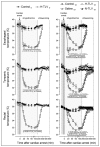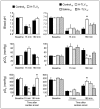Ultrafast and whole-body cooling with total liquid ventilation induces favorable neurological and cardiac outcomes after cardiac arrest in rabbits
- PMID: 21810660
- PMCID: PMC3375236
- DOI: 10.1161/CIRCULATIONAHA.111.039388
Ultrafast and whole-body cooling with total liquid ventilation induces favorable neurological and cardiac outcomes after cardiac arrest in rabbits
Abstract
Background: In animal models of cardiac arrest, the benefit afforded by hypothermia is closely linked to the rapidity of the decrease in body temperature after resuscitation. Because total liquid ventilation (TLV) with temperature-controlled perfluorocarbons induces a very rapid and generalized cooling, we aimed to determine whether this could limit the post-cardiac arrest syndrome in a rabbit model. We especially focused on neurological, cardiac, pulmonary, liver and kidney dysfunctions.
Methods and results: Anesthetized rabbits were submitted to either 5 or 10 minutes of untreated ventricular fibrillation. After cardiopulmonary resuscitation and resumption of a spontaneous circulation, the animals underwent either normothermic life support (control) or therapeutic hypothermia induced by TLV. The latter procedure decreased esophageal and tympanic temperatures to 32°C to 33°C within only 10 minutes. After rewarming, the animals submitted to TLV exhibited an attenuated neurological dysfunction and decreased mortality 7 days later compared with control. The neuroprotective effect of TLV was confirmed by a significant reduction in brain histological damages. We also observed limitation of myocardial necrosis, along with a decrease in troponin I release and a reduced myocardial caspase 3 activity, with TLV. The beneficial effects of TLV were directly related to the rapidity of hypothermia induction because neither conventional cooling (cold saline infusion plus external cooling) nor normothermic TLV elicited a similar protection.
Conclusions: Ultrafast cooling instituted by TLV exerts potent neurological and cardiac protection in an experimental model of cardiac arrest in rabbits. This could be a relevant approach to provide a global and protective hypothermia against the post-cardiac arrest syndrome.
Figures






Comment in
-
Outcomes in elderly intensive care unit patients, pulmonary hypertension in sickle cell disease, and total liquid ventilation for therapeutic hypothermia after cardiac arrest in rabbits.Am J Respir Crit Care Med. 2012 Feb 15;185(4):453-4. doi: 10.1164/rccm.201109-1608RR. Am J Respir Crit Care Med. 2012. PMID: 22336678 Free PMC article. No abstract available.
References
-
- Bernard SA, Gray TW, Buist MD, Jones BM, Silvester W, Gutteridge G, Smith K. Treatment of comatose survivors of out-of-hospital cardiac arrest with induced hypothermia. N Engl J Med. 2002;346:557–563. - PubMed
-
- The Hypothermia After Cardiac Arrest Study Group. Mild therapeutic hypothermia to improve the neurologic outcome after cardiac arrest. N Engl J Med. 2002;346:549–556. - PubMed
-
- Nozari A, Safar P, Stezoski SW, Wu X, Henchir J, Radovsky A, Hanson K, Klein E, Kochanek PM, Tisherman SA. Mild hypothermia during prolonged cardiopulmonary cerebral resuscitation increases conscious survival in dogs. Crit Care Med. 2004;32:2110–2116. - PubMed
-
- Nozari A, Safar P, Stezoski SW, Wu X, Kostelnik S, Radovsky A, Tisherman S, Kochanek PM. Critical time window for intra-arrest cooling with cold saline flush in a dog model of cardiopulmonary resuscitation. Circulation. 2006;113:2690–2696. - PubMed
-
- Guan J, Barbut D, Wang H, Li Y, Tsai MS, Sun S, Inderbitzen B, Weil MH, Tang W. A comparison between head cooling begun during cardiopulmonary resuscitation and surface cooling after resuscitation in a pig model of cardiac arrest. Crit Care Med. 2008;36:S428–433. - PubMed
MeSH terms
Substances
LinkOut - more resources
Full Text Sources
Medical
Research Materials

